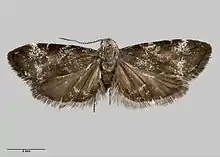Asterivora tristis
Asterivora tristis is a species of moth in the family Choreutidae.[1] It is endemic to New Zealand and has been observed in Tongariro National Park. Adults of this species are on the wing in January.
| Asterivora tristis | |
|---|---|
 | |
| Scientific classification | |
| Kingdom: | |
| Phylum: | |
| Class: | |
| Order: | |
| Family: | |
| Genus: | |
| Species: | A. tristis |
| Binomial name | |
| Asterivora tristis | |
| Synonyms[2] | |
| |
Taxonomy
This species was first described by Alfred Philpott in 1930, using specimens collected on the slopes of Mount Ruapehu at Tongariro National Park in January, and named Simaethis inspoliata.[3] In 1939 George Hudson discussed and illustrated this species under that name.[4] In 1979 J. S. Dugdale placed this species within the genus Asterivora.[5] In 1988 Dugdale confirmed this placement.[2] The male holotype specimen is held at the Auckland War Memorial Museum.[2]
Description
.jpg.webp)
Philpott described this species as follows:
♂. 10-11 mm. Head and thorax dark brown sprinkled with white. Palpi white annulated with black. Antennae black annulated with white, ciliations in ♂ 2. Abdomen dark brown, segmental divisions whitish. Legs dark brown mixed with white. Forewings with costa moderately arched, apex rounded, termen hardly rounded, oblique; deep blackish fuscous densely sprinkled with bluish white scales which tend to form fasciae at base, 1⁄3 and 3⁄4 ; a short streak of whitish scales along termen above tornus; usually a rather conspicuous white spot on costa at 3⁄4; fringes dark drown, tipped with white at tornus and beneath apex. Hindwings dark purplish fuscous; a very obscure whitish fascia from tornus to about middle of wing, sometimes absent: fringes brown, more or less mixed with white and with a broad purplish fuscous basal band.[3]
This species is similar to A. albifasciata but lacks the distinguishing whitish sub-terminal shade of the later species.[4]
Distribution
This species is endemic to New Zealand and has been observed in Tongariro National Park.[1]
Behaviour
The adults of this species are on the wing in January.[4]
References
- Gordon, Dennis P., ed. (2010). New Zealand inventory of biodiversity: Kingdom animalia : chaetognatha, ecdysozoa, ichnofossils. Vol. 2. p. 457. ISBN 978-1-877257-93-3. OCLC 973607714. OL 25288394M. Wikidata Q45922947.
- John Stewart Dugdale (23 September 1988). "Lepidoptera - annotated catalogue, and keys to family-group taxa". Fauna of New Zealand. Department of Scientific and Industrial Research. 14: 114. doi:10.7931/J2/FNZ.14. ISSN 0111-5383. Wikidata Q45083134.
- Philpott, Alfred (1930). "New Species of Lepidoptera in the Collection of the Auckland Museum". Records of the Auckland Institute and Museum. 1: 12–13. ISSN 0067-0464. JSTOR 42905932. Wikidata Q58676529.
- George Vernon Hudson (1939), A supplement to the butterflies and moths of New Zealand, Illustrator: George Hudson, Wellington, p. 457, OCLC 9742724, Wikidata Q109420935
{{citation}}: CS1 maint: location missing publisher (link) - J. S. Dugdale (July 1979). "A new generic name for the New Zealand species previously assigned to Simaethis auctorum (Lepidoptera: Choreutidae), with description of a new species". New Zealand Journal of Zoology. 6 (3): 461–466. doi:10.1080/03014223.1979.10428386. ISSN 0301-4223. Wikidata Q54576372.